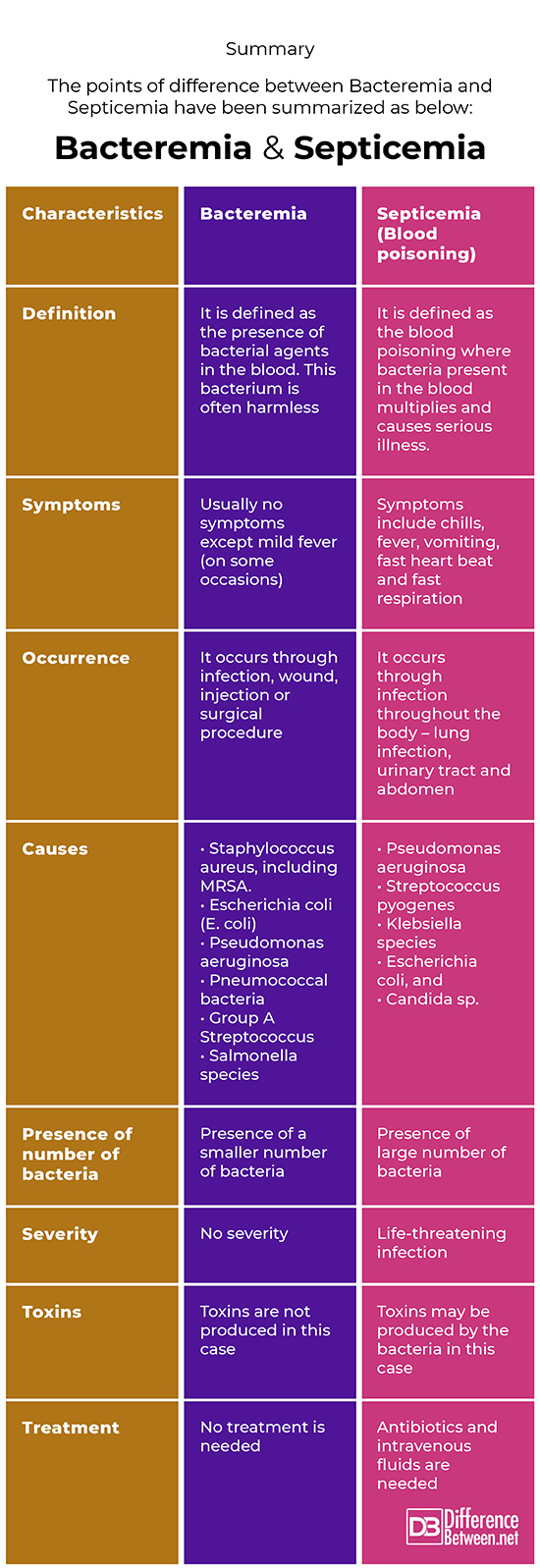Difference Between Bacteremia and Septicemia
What are bacteremia and septicemia?
The presence of bacteria in the blood stream is known as bacteremia or septicemia. However, there is a difference between the two. Bacteremia is just the simple presence of bacteria in the blood and Septicemia is the blood poisoning caused by the presence and multiplication of the bacteria in the blood. Septicemia is dangerous and life-threatening than bacteremia.
Similarity
Both are the infections caused by the bacterial presence.

Bacteremia
Bacteremia in the strictest sense, is an infection in the blood caused by the bacteria or it is the presence of viable bacteria in the bloodstream. It is not dangerous and usually does not require any treatment. The body’ immune system clears it off.

Septicemia
It is a life-threatening infection or complication caused by the entry and multiplication of bacteria in the bloodstream. It is also termed as ‘blood poisoning’.
Difference between bacteremia and septicemia?
Definition
Bacteremia
Curable bacterial infection in the blood stream – as harmless as vigorous tooth brushing. A small number of bacteria are noticed in this case removed by the body on its own. Occasionally, bacteremia progresses to dangerous infection called septicemia and sepsis.
Septicemia
The presence of Systemic Inflammatory Response Syndrome with an identifiable infection source. It is a clinical name for blood poisoning.
Symptoms
Bacteremia
Cases in this case are asymptomatic. People with stronger immune system will clear the bacterial without you even realizing it.
Septicemia
Symptoms include;
- Breathlessness or breathing very fast
- Fever and chills
- Very low body temperature
- Difficulty in breathing (grunting noises)
- Peeing less than usual
- Mental confusion
- Fast heartbeat
- Nausea and vomiting
- Flushing
- Dizziness
- Diarrhea
- Inadequate blood flow
- Fatigue or weakness
- Shock
- Blotchy, pale or discolored skin
Types
Bacteremia
Types of bacteremia;
Extravascular – via the lymphatics (Those that result from bacteria entering the blood circulation through the lymphatic system from another site of infection). Most cases are a result of extravascular infection.
Intravascular – i.e CVC infections (Endocarditis, Mycotic aneurism, Suppurative thrombophlebitis, intravenous catheter-associated bacteremia)
Types of bacteremia;
Transient – Disruption of mucosal surfaces (dental or surgical procedures)
Intermittent – Associated with abscesses
Continuous – Infective endocarditis
Septicemia
The 3 types of sepsis are: sepsis (serious complication of an infection), severe sepsis associated with organ dysfunction, hypoperfusion, or hypotension), and septic shock (infection causing organ failure).
Diagnosis
Diagnosis of Bacteremia
This is diagnosed by blood culture test. Sample of blood is sent to lab and tested for bacterial presence.
Diagnosis of Septicemia
- Tests on multiple types of fluids to diagnose a bacterial infection. These fluids could be;
- Blood
- Skin sores and wound secretions
- Urine
- respiratory secretions
- Your health practitioner may also look at your oxygen and carbon dioxide levels in the blood to check your breathing problems
- If infection is not diagnosed by above mentioned ways, then other ways can be adopted like:
- X-ray
- MRI
- CT scan
- Ultrasound
Type of infection
Bacteremia types
Some ways in which bacteremia happens include:
- Dental procedures like tooth extraction, root canal, surgery
- Infection that progresses into the bloodstream via dwelling catheters, medical devices, and breathing tubes
- By burns and severe injuries
Septicemia types
Both bacterial, viral or fungal infection can result in septicemia. These are usually infections of:
- Pneumonia (Lung infection)
- Infection of the digestive system
- Infection of the kidney, bladder and other regions in the urinary system
- Infection of the bloodstream (bacteremia)
- Infection of the catheter sites
- Burns or wounds
Causes
Causes of Bacteremia
Caused by Clostridium difficile, Pseudomonas, Staphylococcus, Hemophilus, E. coli, herpes, urinary tract infections, Streptococcus, peritonitis,
Causes of Septicemia
Staphylococci, are thought to cause more than fifty percent of cases of sepsis. Other bacteria include Pseudomonas aeruginosa, Streptococcus pyogenes, Klebsiella species, Escherichia coli, and even Candida sp.
Summary
The points of difference between Bacteremia and Septicemia have been summarized as below:

FAQ
When does bacteremia progress to septicemia?
When immune response systems decline or become overwhelmed, bacteremia and infection progress to the bloodstream and it becomes a bloodstream infection that can evolve into several clinical manifestations and is recognized as septicemia.
What is difference between sepsis and septicemia?
Septicemia occurs when there is bacterial infection entering the bloodstream. This infection is also termed as blood poisoning and the body’s most extreme response to this infection triggers sepsis. Sepsis is a dangerous and life-threatening condition that can result in damage to the body tissues, multiple organ failure and even death.
Does bacteremia equal sepsis?
No, bacteremia is not a perquisite component resulting in the inflammatory response that causes sepsis
What are the 3 stages of sepsis?
The 3 stages of sepsis are: sepsis (serious complication of an infection), severe sepsis associated with organ dysfunction, hypoperfusion, or hypotension), and septic shock (infection causing organ failure).
Can you have septicemia without bacteremia?
No, that is not possible. Septicemia is caused when bacteria find its way into the blood stream and bacteremia becomes a bloodstream infection due to failure of immune response mechanisms.
- Difference Between Global Warming and Greenhouse Effect - May 18, 2024
- Difference Between Vaccination and Immunization - March 3, 2024
- Difference Between Selective Mutism and Autism - February 25, 2024
Search DifferenceBetween.net :
Leave a Response
References :
[0]Bates, D. W., Pruess, K. E., & Lee, T. H. (1995). How bad are bacteremia and sepsis?: Outcomes in a cohort with suspected bacteremia. Archives of internal medicine, 155(6), 593-598.
[1]Berg D, Gerlach H. Recent advances in understanding and managing sepsis. F1000Res. 2018;7:F1000 Faculty Rev-1570. Published 2018 Sep 28. doi:10.12688/f1000research.15758.1
[2]Berkley, J. A., Lowe, B. S., Mwangi, I., Williams, T., Bauni, E., Mwarumba, S., ... & Scott, J. A. G. (2005). Bacteremia among children admitted to a rural hospital in Kenya. New England Journal of Medicine, 352(1), 39-47.
[3]Gyawali B, Ramakrishna K, Dhamoon AS. Sepsis: The evolution in definition, pathophysiology, and management. SAGE Open Med. 2019; 7:2050312119835043. Published 2019 August 21. doi:10.1177/2050312119835043
[4]Image credit: https://pixnio.com/free-images/science/microscopy-images/brucellosis-brucella/brucella-spp-are-gram-negative-in-their-staining-morphology-550x438.jpg
[5]Image credit: https://pix4free.org/assets/library/2021-03-25/originals/septicemia.jpg
